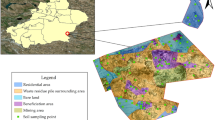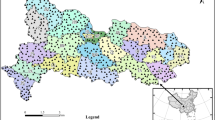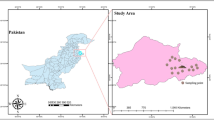Abstract
Human health risk assessment increasingly recognizes the need to integrate participatory-based research, geospatial analysis, and environmental epidemiology, particularly to address contamination concerns in underserved and disadvantaged communities. Here, we demonstrate the combined application of such methods within the Greater Fifth Ward neighborhood in Northeast Houston. In particular, in tandem with community members, we collected soil samples from 193 residential sites using a complete canvassing method from July to November 2021 to characterize contaminant concentrations, focusing on heavy metals and metalloids As, Ba, Cd, Cr, Pb, Se, Ag, and Hg measured using Inductively Coupled Plasma-Mass Spectrometry. Individual heavy metals as well as cumulative cancer and non-cancer risks were calculated for children and adults using the USEPA Regional Soil Screening Levels and benchmarks for specific land uses, such as crop growing. Soils from most sites had low or typical background levels expected in urban areas, but samples from several locations had significantly elevated lead levels (>1200 mg/kg) that warrant additional examination. Geospatial analysis suggested clustering of heavy metal contaminants within one geographic area of the neighborhood. This study highlights how participatory research in underserved environmental justice communities can help characterize current conditions as well as establish priorities for future investigation.
This is a preview of subscription content, access via your institution
Access options
Subscribe to this journal
Receive 6 print issues and online access
$259.00 per year
only $43.17 per issue
Buy this article
- Purchase on SpringerLink
- Instant access to full article PDF
Prices may be subject to local taxes which are calculated during checkout



Similar content being viewed by others
References
Gautam PK, Gautam RK, Banerjee S, Chattopadhyaya MC, Pandey JD. Heavy metals in the environment: fate, transport, toxicity and remediation technologies. Nova Sci Publ. 2016;60:101–30.
Tchounwou PB, Yedjou CG, Patlolla AK, Sutton DJ. Heavy metal toxicity and the environment. Molecular, clinical and environmental toxicology: volume 3: environmental toxicology. Springer; 2012. 133–64.
He Z, Shentu J, Yang X, Baligar VC, Zhang T, Stoffella PJ. Heavy metal contamination of soils: sources, indicators and assessment. J Environ Indic. 2015;9:17–8.
Rehman K, Fatima F, Waheed I, Akash MSH. Prevalence of exposure of heavy metals and their impact on health consequences. J Cell Biochem. 2018;119:157–84.
Jaishankar M, Tseten T, Anbalagan N, Mathew BB, Beeregowda KN. Toxicity, mechanism and health effects of some heavy metals. Interdiscip Toxicol. 2014;7:60.
Laidlaw MA, Filippelli GM. Resuspension of urban soils as a persistent source of lead poisoning in children: a review and new directions. Appl Geochem. 2008;23:2021–39.
Smith AH, Hopenhayn-Rich C, Bates MN, Goeden HM, Hertz-Picciotto I, Duggan HM, et al. Cancer risks from arsenic in drinking water. Environ Health Perspect. 1992;97:259–67.
Agency for Toxic Substances and Disease Registry. Addendum to the Toxicological Profile for Arsenic, 2016. Available from: https://www.atsdr.cdc.gov/toxprofiles/Arsenic_addendum.pdf.
Leech TG, Adams EA, Weathers TD, Staten LK, Filippelli GM. Inequitable chronic lead exposure: a dual legacy of social and environmental injustice. Fam Community Health. 2016;39:151–9.
Fawkes LS, McDonald TJ, Roh T, Chiu WA, Taylor RJ, Sansom GT. A participatory-based research approach for assessing exposure to lead-contaminated drinking water in the Houston Neighborhood of the Greater Fifth Ward. Int J Environ Res public health. 2022;19:8135.
Jones DH, Yu X, Guo Q, Duan X, Jia C. Racial disparities in the heavy metal contamination of urban soil in the Southeastern United States. Int J Environ Res Public Health. 2022;19:1105.
Hwang H-M, Fiala MJ, Park D, Wade TL. Review of pollutants in urban road dust and stormwater runoff: part 1. Heavy metals released from vehicles. Int J Urban Sci. 2016;20:334–60.
Minkler M, Vásquez VB, Tajik M, Petersen D. Promoting environmental justice through community-based participatory research: the role of community and partnership capacity. Health Educ Behav. 2008;35:119–37.
Satija N. Houston’s historically black neighborhoods devastated by flooding, with little safety net. The Texas Tribune; 2017.
United States Environmental Protection Agency USE. Superfund Site: North Cavalcade Street Houston, TX n.d. Available from: https://cumulis.epa.gov/supercpad/cursites/csitinfo.cfm?id=0602956.
United States Environmental Protection Agency. FRS Facility Query Results 2015. Available from: https://ofmpub.epa.gov/frs_public2/fii_map_master.fii_retrieve?fac_search=primary_name&fac_value=&fac_search_type=Beginning+With&postal_code=77020&location_address=&add_search_type=B&city_name=&county_name=&state_code=&epa_region_code=&cong_dist=&legis_dist=&huc_code=&fed_agency=&TribalLand=0&selectTribe=noselect&sic_type=Equal+to&sic_code_to=&naic_type=Equal+to&naic_to=&org_name=&duns_num=&prog_search=&int_search=&search_type=&search_type=all&all_programs=YES&sysname=&page_no=1&output_sql_switch=TRUE&report=1&database_type=FII&tribal_ind=&last_facility=&univ_search=&fac_search_term=&tribetype=&triballand=&selecttribe=&tribedistance1=
City of Houston PDD. NO. 55 Superneighborhood, Resource Assessment 2021. Available from: https://www.houstontx.gov/planning/Demographics/2019%20Council%20District%20Profiles/Greater_FifthWard_Final.pdf
Texas Department of State Health Services. Assessment of the Occurrence of Cancer Houston, Texas 2020. Available from: https://www.houstontx.gov/planning/Demographics/2019%20Council%20District%20Profiles/Greater_FifthWard_Final.pdf
Houston Health Department Bureau of Community and Children’s Environmental Health. Stories from the Field: 2019 Health in All Policies (Childhood Lead Poisoning Prevention) Mini-Grantee. 2019.
Aly NA, Casillas G, Luo Y-S, McDonald TJ, Wade TL, Zhu R, et al. Environmental impacts of Hurricane Florence flooding in eastern North Carolina: temporal analysis of contaminant distribution and potential human health risks. J Expo Sci Environ Epidemiol. 2021;31:810–22.
United States Environmental Protection Agency. Regional Screening Levels (RSLs)-Generic Tables: November 2022. 2022. Available from: https://www.epa.gov/risk/regional-screening-levels-rsls-generic-tables
Ogunlaja A, Ogunlaja OO, Okewole DM, Morenikeji OA. Risk assessment and source identification of heavy metal contamination by multivariate and hazard index analyses of a pipeline vandalised area in Lagos State, Nigeria. Sci Total Environ. 2019;651:2943–52.
United States Environmental Protection Agency. Role of the Baseline Risk Assessment in Superfund Remedy Selection Decisions. OSWER Directive 9355.0-30 1991. https://www.epa.gov/sites/default/files/2015-11/documents/baseline.pdf
United States Environmental Protection Agency. Hazard Standards for Lead in Paint, Dust and Soil (TSCA Section 403) 2016. https://19january2017snapshot.epa.gov/lead/hazard-standards-lead-paint-dust-and-soil-tsca-section-403_.html#:~:text=Under%20these%20standards%2C%20lead%20is%20considered%20a%20hazard,bare%20soil%20in%20the%20rest%20of%20the%20yard
Texas Register. Texas Administrative Code, 30 TAC §350.51(m) 1999 https://texreg.sos.state.tx.us/fids/200700768-1.html
Mielke HW, Gonzales CR, Powell ET, Egendorf SP. Lead in air, soil, and blood: Pb poisoning in a changing world. Int J Environ Res Public Health. 2022;19:9500.
Texas Register. 30 TAC §350.51(m) n.d. https://texreg.sos.state.tx.us/fids/200700768-1.html
Agency for Toxic Substances and Disease Registry. Substance Priority List 2022. https://www.atsdr.cdc.gov/spl/index.html
Acknowledgements
We would like to thank the following organizations and individuals for their support: Coalition of Community Organizations (COCO), IMPACT, the Greater Fifth Ward Block Captains, Texas Southern University—The Bullard Center, Environmental Defense Fund, and the Greater Fifth Ward community who allowed us to sample their properties and engaged in discussions about potential environmental exposures, and thank you to all of the Texas A&M University students who assisted in research related to this study.
Funding
Funding for this study came from the Texas A&M Superfund Research Center (National Institute of Environmental Health Sciences P12ES027704-01-Center), the National Academies’ Gulf Research Program Early-Career Research Fellow, and a School of Public Health Dissertation Scholarship bestowed by Drs. Tiffany Radcliff, Garett T. Sansom, and Taehyun Roh without whom this research would not have been possible.
Author information
Authors and Affiliations
Contributions
Leanne S. Fawkes: Investigation, conceptualization, formal analysis, methodology, visualization, writing-original draft. Weihsueh A. Chiu: Conceptualization, formal analysis, writing-review & editing. Thomas J. McDonald: Writing-review & editing. Taehyun Roh: Writing-review & editing. Garett T. Sansom: Conceptualization, methodology, writing-review & editing.
Corresponding author
Ethics declarations
Competing interests
The authors declare no competing interests.
Ethics approval and consent to participate
This project and all related materials were approved by the Texas A&M University Institutional Review Board (IRB2021-0357D). Informed consent was obtained from all subjects involved in the study.
Additional information
Publisher’s note Springer Nature remains neutral with regard to jurisdictional claims in published maps and institutional affiliations.
Supplementary information
Rights and permissions
Springer Nature or its licensor (e.g. a society or other partner) holds exclusive rights to this article under a publishing agreement with the author(s) or other rightsholder(s); author self-archiving of the accepted manuscript version of this article is solely governed by the terms of such publishing agreement and applicable law.
About this article
Cite this article
Fawkes, L.S., Chiu, W.A., Roh, T. et al. Human health risk assessment of heavy metals in residential soil—Houston, Texas. J Expo Sci Environ Epidemiol 35, 725–729 (2025). https://doi.org/10.1038/s41370-024-00713-7
Received:
Revised:
Accepted:
Published:
Issue date:
DOI: https://doi.org/10.1038/s41370-024-00713-7



